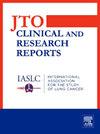一项前瞻性探索性研究,通过预处理干扰素γ释放法评估晚期非小细胞肺癌患者不同全身治疗的功能免疫
IF 3.5
Q2 ONCOLOGY
引用次数: 0
摘要
晚期非小细胞肺癌化疗和免疫治疗反应的预测标志物有限,没有客观的工具来评估免疫功能,而免疫功能对治疗结果至关重要。本研究前瞻性地评估了干扰素γ (IFN-γ)释放试验(IGRA)作为治疗反应的潜在预测因子和评估免疫功能的工具。方法:我们招募了正在接受一线化疗、EGFR酪氨酸激酶抑制剂(TKI)治疗或任何单药免疫治疗的IV期NSCLC患者,以及I期对照。采用QuantiFERON-TB金管(QFT-GIT)试剂盒采集外周血样本进行IGRA检测。采用QFT-GIT和内部酶联免疫吸附法测量植物血凝素刺激的IFN-γ (PSIG)反应,根据中位预处理值将IV期患者分为高PSIG反应组和低PSIG反应组。结果共分析117例患者,其中手术32例,EGFR TKI 30例,化疗25例,免疫治疗30例。I期患者的PSIG应答中位数显著高于IV期(1420 pg/mL vs 960 pg/mL;P = 0.032)。在IV期,驱动突变患者有更高的预处理PSIG反应(1278 pg/mL vs 288 pg/mL;P = 0.004)。Kaplan-Meier分析显示,EGFR TKI组和免疫治疗组的无进展生存期和总生存期较长,PSIG反应较高,但无统计学意义。结论晚期非小细胞肺癌患者淋巴细胞功能降低,驱动突变患者淋巴细胞耗竭程度较低。IGRA显示了作为评估这些患者免疫功能的临床工具的潜力。本文章由计算机程序翻译,如有差异,请以英文原文为准。
A Prospective Exploratory Study of Functional Immunity Assessed by Pretreatment Interferon Gamma Release Assay in Relation to Different Systemic Therapies in Patients With Advanced-Stage NSCLC
Introduction
Predictive markers for chemotherapy and immunotherapy response in advanced NSCLC are limited, and no objective tool exists to assess immune function, which is critical for treatment outcomes. This study prospectively evaluated the interferon gamma (IFN-γ) release assay (IGRA) as a potential predictor of treatment response and a tool for assessing immune function.
Methods
We enrolled patients with stage IV NSCLC undergoing first-line chemotherapy, EGFR tyrosine kinase inhibitor (TKI) therapy, or any line of single-agent immunotherapy, alongside stage I controls. Peripheral blood samples were collected pre- and post-treatment for IGRA testing using the QuantiFERON-TB Gold In-Tube (QFT-GIT) kit. Phytohemagglutinin-stimulated IFN-γ (PSIG) responses were measured by both QFT-GIT and in-house enzyme-linked immunosorbent assay, with stage IV patients categorized into high- and low-PSIG response groups based on median pretreatment values.
Results
A total of 117 patients were analyzed (32 surgery, 30 EGFR TKI, 25 chemotherapy, 30 immunotherapy). The median PSIG response was significantly higher in stage I patients than stage IV (1420 pg/mL versus 960 pg/mL; p = 0.032). In stage IV, those with driver mutations had higher pretreatment PSIG responses (1278 pg/mL versus 288 pg/mL; p = 0.004). Kaplan–Meier analysis suggested a trend toward longer progression-free and overall survival in the EGFR TKI and immunotherapy groups with higher PSIG responses, though not statistically significant.
Conclusions
Patients with advanced-stage NSCLC exhibited reduced lymphocyte function, and patients with driver mutations correlated to less exhausted lymphocyte. IGRA demonstrates potential as a clinical tool for assessing immune function in these patients.
求助全文
通过发布文献求助,成功后即可免费获取论文全文。
去求助
来源期刊

JTO Clinical and Research Reports
Medicine-Oncology
CiteScore
4.20
自引率
0.00%
发文量
145
审稿时长
19 weeks
 求助内容:
求助内容: 应助结果提醒方式:
应助结果提醒方式:


